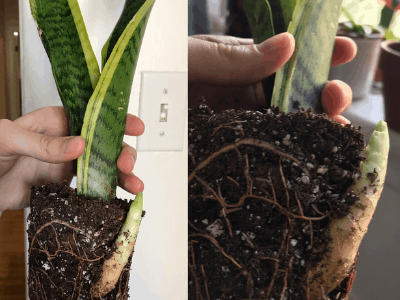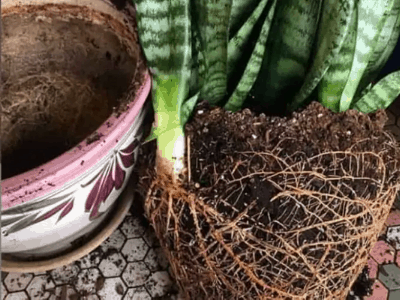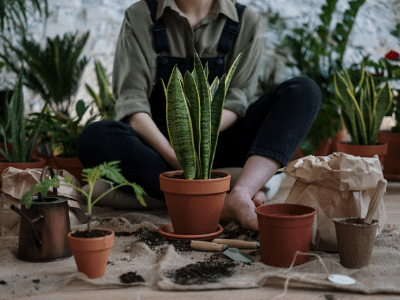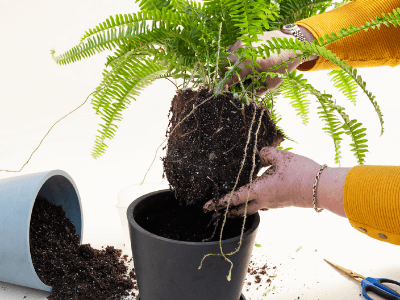
Repot a Snake Plant, Is It Needed?
You will eventually need to transplant your Sansevieria, also called Mother in law tongue or snake plant…
… to a larger container.
At that time, its leaves will grow outside the pot. Repot a snake plant is surely needed for its growing,
Occasionally, due to the edges of the container, foliage might seem to be suffering.
If this is the case, it might be time to repot a snake plant. Sanseviera varieties can grow horizontally or vertically.
Many grow tall instead of wide. When grown outdoors in favorable weather conditions…
…snake plants can thrive and reproduce rapidly.
Rhizomes, or horizontally spreading underground stems, are instrumental in the proliferation process.
Unlike seedlings that have more room both underground and through the foliage…
…a potted plant does not have that much space to spread out.
Therefore, they need to be transferred to a larger pot after a few years.
Whether your snake plant is due for a repot or not, this post gives you insight into why and how to do it properly.
Here are the story from Xavier, about his experience for repotting snake plant for the very first time.
Let us hear Xavier’s story
A snake plant had been sitting for a while in the same pot. When I came home from work…
…I saw it and thought about how much time had passed since we initially planted it.
It was at this moment that I decided to repot the snake plant because it seemed like something…
…needed to be done with this neglected houseplant.
After researching different types of pots and soil combinations, I finally settled on planting the snake plant…
….in a terra cotta pot with my own homemade mixture of organic dirt mixed with vermiculite (it helps retain moisture).
The next day when I looked out into our backyard, the newly transplanted snake plant was full of life!

The best time to do this repotting is in the late winter or very early spring. This puts the transplant during the time of year that the plant’s not in active growth mode.
Kevin Espiritu, Founder of epicgardening.com
Here’s the main things that you should know!
Why Repot?
Although most snake plants love to be root-bound, repotting may be necessary if the roots…
…have no space left to spread. As your plant grows, it fills its container and grows too big for its original pot.
During this time, the plant may be uncomfortable and in distress, leading to stunted growth…
…or curled or damaged leaves. The plant may not receive sufficient nutrients and moisture…
..from the soil mix because it is so big. Plants that have densely packed leaves may also have trouble…
…photosynthesising. When roots are crowded inside the soil, it causes the soil to become dense…
…and hard to drain water.
The soil is compacted, which is particularly detrimental to snake plants since they prefer loose…
…uncompressed soil. The density of the soil can lead to root rot.
Therefore, repotting snake plants are a good idea periodically.

Here’s the thing….
Benefits of Repotting
Your snake plant’s main benefit is that it will grow healthy in its new pot. In the new pot…
…the snake plant can grow freely. Repotting also allows you to replace the soil.
For example, you can make your soil more breathable by mixing in some perlite or sand.
You can also fertilize an old soil with depleted nutrients. With a medium or large sized plant…
…repotting also provides the opportunity to divide the plant in two or three parts…
…allowing you to propagate it and grow new plants.

New facts for you!
When to Repot?
The growth of your plants will be compromised if they are not given enough space to grow.
You should watch for these signs to know if it’s time to repot your plants.
- There are roots growing through the pot’s drainage holes.
- There are roots growing on the surface of your container.
- Containers bulge outwards when roots cannot be accommodated inside the containers. Plastic containers bulge outwards more than other materials.
- Pots made of clay or terracotta are cracking.
- It looks like the foliage is stuck in the pot, and the plant is difficult to remove from it.
In the event that any of these signs appear in your plant, you should probably move it to a larger container.
Snake plants begin to grow and flower in spring time, which is especially true for Sansevieria.
Therefore, late winter or early spring seem to be the ideal time for repotting.
You can repot a plant whenever necessary according to the needs of the plant.
Putting it in a new pot at the end of the winter will allow you to see your plant grow and expand in the spring.
A snake plant generally needs to be replanted about every 3 to 5 years, but in some cases, it can even wait 6 years.
It depends on how fast the plant grows and what size container you choose.
Meanwhile, make sure the plants look healthy in their pots.

Go on…
Repotting Preparation
You’ll need these items for repotting your snake plant after you decide to do it.
Pot
When choosing a pot for your plant, make sure that it is suitable for the new plant…
…and will not require repotting any time soon.
The size of your pot depends on how old and how big the plant itself. You should select a pot that is at least one…
…or two inches larger than the old one.
Since snake plants often grow quite high, it is also crucial to consider the pot’s depth.
The new container might be too shallow, so the plant might become top-heavy, leading to tipping.
You should ensure that your container has a bottom drainage hole to allow for smooth drainage.
This will prevent excess water from building up. If you wish to invest in a pot, make sure it has a stand…
…tray or drainage saucer. You can choose from plastic, ceramic, terracotta, or any other type of material.
Soil
For snake plants, loose, free-draining soil is a must, as they like to be on the drier side.
Snake plants require very little water, and overwatering is a problem.
The roots of snake plants rot when exposed to soggy soil for an extended period of time.
If you mix in the cacti and succulent mix into garden soil, mother in law’s tongue will thrive.
You can also use soilless potting mix for tropical plants.
Additionally, you can use soil mixed with other ingredients like sand and perlite to make your own potting mix.
Adding compost or manure to soil will provide it with additional nutrients and microbes…
…as long as it provides proper drainage.
Tools
Apart from a pot and soil, you might need some equipment such as:
- Dull knife – Knife is helpful to loosen the plant from its container.
- Pruners or shears – If you want to divide the plant, garden shears, pruners or a knife is necessary to cut the roots and rhizomes.
- Gloves – to keep your hands clean.
- Garden trowel – for digging and scooping up the soil.
- Cloth, mesh tape, marbles, gravel or pebbles – to put on the drainage holes in a pot, so that soil doesn’t escape from the holes.
How to repot a snake plant?
Now that you’ve prepared yourself for repotting, let’s see how you can do it.
Following these easy steps will make repotting a snake plant a breeze.
Step 1
In the first step, remove the plant from its container. Flooding the soil from roots is important to loosen it.
Using a knife, remove soil from the container’s edge.
Place the pot horizontally on the ground and gently thump the sides, then pull out the plant.
If its roots aren’t coming out, try using a trowel to loosen more soil.
You should then turn the pot upside down and gently tap it until the plant comes out…
…taking care not to damage any roots or leaves while you do so.
Step 2
After taking the snake plant out, check the roots carefully. Snake plants are prone to root rot…
…so look out for any signs of rotting. If you notice mushy and dark spots on the roots, it indicates the rot…
…has already begun. However, this is an easy problem to solve.
Simply use a clean knife or shears to trim away the rotten parts.
To make sure the plant doesn’t overgrow in its new pot, you can also trim off any overly large…
…bulging roots on the root ball.
Follow these guidelines to propagate your plant by division if you wish to slice through its roots.
You can divide your plants if you wish.
Step 3
If the soil is suitable for reuse, you can examine it further to determine if you want to put it to further use.
Good soil drains well and can be reused. However, even thick soil can often be saved by adding sand, peat…
…perlite, or cactus potting mix to improve drainage, as well as worm compost or animal manure to add nourishment.
Step 4
After the container has been filled with potting soil, you need to make sure that the drainage holes are completely open.
Then you need to cover the holes so the soil doesn’t just run through them while the soil is still wet.
Then, you should either cover up the holes with mesh tape or a small cloth. If your pot has holes…
…you can also put marbles, pebbles, or gravel at the bottom, and then fill it with soil mix.
To determine the approximate depth to which soil should be poured before planting the plant…
…simply measure the length of the root bulb with a knife or trowel.
Step 5
Putting the snake plant in the pot is the final step. Make sure it is planted at the same depth as before.
The root ball should be just below the surface of the soil.
Keep at least 1-2 inches of space between the pot rim and the top of the soil layer.
Keep the plant in the center, and slowly add soil, using one hand to keep the soil moist.
You can finish the soil with a thin layer of compost, decorative rocks, and marbles.
Last but not least…
After Care
Snake plant aftercare is essential to avoid transplant shock, so here are some tips…
…on caring for your snake plants after repotting.
When repotting, don’t water the plant right after it is removed from the old pot…
…especially if the soil was moistened. Let the soil get dry for a few days.
If you have watered the soil too much, let it drain out all the excess water. This will keep the roots from rotting.
If you are handling snake plants for the first time, place them in bright indirect sunlight for at least one month.
Direct sunlight is too harsh for the plants after repotting.
Plants should not be fertilized right away if you want to avoid burning their roots.
Allow them to grow roots for at least a month before fertilizing.
Sum Up
See having Snake plant is good choice for you to have! It’s cool, its famous, it’s easy to have and care!
What else do you need? In this pandemic time like this, is a good choice for you to have an new activity…
…and having snake plant is a good choice for you to have!
Conclusion
The following article should help you better understand why repotting is necessary…
…as well as the step-by-step procedure of how to do it. It’s a fun and easy project for your plants.
Last thing for sure. This plant need to be care carefully, remember plant need the “love” too.
Alright that’s all for today! Do you have any questions about all of this?
Or do you want to add some more tips and guide to repot a snake plant?
Let me know your recommendation from the comment below.
There are still many recent and interesting articles about Snake Plants as well as other unique information…
…from All Things Gardener. For further information and other inquiries you can contact us here
I hope you can now take care your snake carefully and grow it big!
Thanks for reading this article! Bye!

